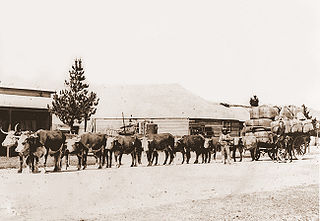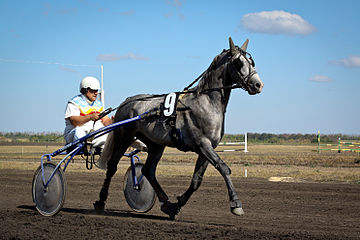This article concerns systems of transport in Lesotho. As a landlocked country, Lesotho has no seaports or harbours, but does have road, air transport, and limited rail infrastructure.

A sled, skid, sledge, or sleigh is a land vehicle that slides across a surface, usually of ice or snow. It is built with either a smooth underside or a separate body supported by two or more smooth, relatively narrow, longitudinal runners similar in principle to skis. This reduces the amount of friction, which helps to carry heavy loads.

A carriage is a two- or four-wheeled horse-drawn vehicle for passengers. Second-hand private carriages were common public transport, the equivalent of modern cars used as taxis. Carriage suspensions are by leather strapping or, on those made in recent centuries, steel springs. Two-wheeled carriages are usually owner-driven.

A wagon or waggon is a heavy four-wheeled vehicle pulled by draught animals or on occasion by humans, used for transporting goods, commodities, agricultural materials, supplies and sometimes people.

A pack animal, also known as a sumpter animal or beast of burden, is an individual or type of working animal used by humans as means of transporting materials by attaching them so their weight bears on the animal's back, in contrast to draft animals which pull loads but do not carry them.

A kalesa, is a two-wheeled horse-drawn carriage used in the Philippines. It is commonly vividly painted and decorated. It was a primary mode of public and private transportation during the Spanish colonial era of the Philippines, though in modern times, they largely only survive as tourist attractions, such as in Vigan, Ilocos Sur.

A working animal is an animal, usually domesticated, that is kept by humans and trained to perform tasks instead of being slaughtered to harvest animal products. Some are used for their physical strength or for transportation, while others are service animals trained to execute certain specialized tasks. They may also be used for milking or herding. Some, at the end of their working lives, may also be used for meat or leather.

A bullock cart or ox cart is a two-wheeled or four-wheeled vehicle pulled by oxen. It is a means of transportation used since ancient times in many parts of the world. They are still used today where modern vehicles are too expensive or the infrastructure favor them.

A horse-drawn vehicle is a piece of equipment pulled by one or more horses. These vehicles typically have two or four wheels and were used to carry passengers or a load. They were once common worldwide, but they have mostly been replaced by automobiles and other forms of self-propelled transport but are still in use today.

A lorry or lorrie was a low flat horse-drawn vehicle with no sides, related to the trolley and dray.

A dogcart is a two-wheeled horse-drawn vehicle pulled by a single horse in shafts, or driven tandem. With seating for four, it was designed for sporting shooters and their gun dogs, with a louvred box under the driver's seat to contain dogs. It was developed in the early 1800s to afford more seating than the gig, which seats only two. Seating is two back-to-back crosswise seats, an arrangement called dos-à-dos from French. There is a hinged tailboard which lowers slightly and, supported by chains, acts as a footrest for the rear-facing passengers. Some dogcarts had a mechanism to slide the entire body forward or rearward along the shafts to help balance the weight for the horse.

An ox-wagon or bullock wagon is a four-wheeled vehicle pulled by oxen. It was a traditional form of transport, especially in Southern Africa but also in New Zealand and Australia. Ox-wagons were also used in the United States. The first recorded use of an ox-wagon was around 1670, but they continue to be used in some areas up to modern times.

A tonga or tanga is a two-wheeled cart drawn by a single horse. It is used for transportation in the Indian subcontinent. There is a canopy over the body, one seat faces forward for the driver and one passenger, and one seat faces the rear for a second passenger. Some space is available for baggage below the carriage, between the wheels. This space is often used to carry hay for the horses.
The following outline is provided as an overview of and topical guide to transport:

A two-wheeler is a vehicle that runs on two wheels.

Driving, when applied to horses, ponies, mules, or donkeys, is a broad term for hitching equines to a wagon, carriage, cart, sleigh, or other horse-drawn vehicle by means of a harness and working them in this way. It encompasses a wide range of activities from pleasure driving, to harness racing, to farm work, horse shows, and even international combined driving.

A float is a form of two-wheeled horse-drawn cart with a dropped axle to give an especially low load-bed. They were intended for use by deliverymen and the carrying of heavy or unstable items such as milk churns.
A flatbed trolley a common form of freight transport in distribution environments, for moving bulk loads. Trolleys can aid in reducing effort required to move a load by allowing the user to pull or push instead of lift and carry. A very simple design offers a basic flat platform with four casters and a fixed handle which is used to either push or pull the platform with the load on the platform. Without a flat surface it becomes an open frame trolley and without a handle it is a bogie or dolly.
The wheel in Africa was used, to various extents, throughout the history of Africa. While it may have been common for Africans to manually carry their goods or use pack animals to transport economic goods in Africa, there was broad awareness, knowledge, and use of wheeled transports in Africa. However, the environment in some parts of tropical Africa, as well as alternative forms of travel and transport, such as via canoe and beasts of burden/riding animals, may have resulted in decreased use of animal-drawn wheeled transport in Africa. The wheel was also given other technical applications in Africa, such as a water wheel and a potter's wheel.

































